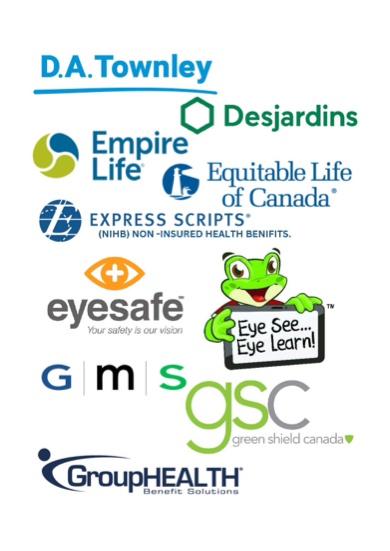Vision helps us process the world around us, but it’s under constant threat by silent conditions such as glaucoma. It’s the leading cause of irreversible vision loss in Canada, so it’s no surprise this condition raises widespread apprehension.
Unfortunately, it can also be hard to detect, as it may have no symptoms in the early stages. This makes understanding your personal risk vital. Glaucoma can be hereditary, so annual eye exams are one of the best ways to watch for early signs. Be aware of your family medical history and the possibility of glaucoma. With a focus on proactive care, we can help preserve your vision.
What Is Glaucoma?
Glaucoma is a group of eye diseases characterized by progressive damage to the optic nerve, which carries information from the eye to the brain. This damage is often caused by elevated intraocular pressure (IOP), a fluid pressure build-up inside the eye that begins to harm the optic nerve over time. If left untreated, glaucoma can lead to irreversible blindness.
There are 4 primary types of glaucoma, including:
- Open-angle glaucoma: Open-angle glaucoma is the most common type, making up around 90% of cases. The “open angle” refers to the drainage between the iris and the cornea. In this type, the fluid should be able to drain from the eyes, but for some reason, it doesn’t. This causes a slow, steady increase in IOP, leading to gradual vision loss.
- Angle-closure glaucoma: Angle-closure glaucoma occurs when the angle between the iris and cornea is blocked. This can nearly completely prevent fluids from draining from the eye. IOP increases suddenly, leading to noticeable symptoms like eye pain and blurry vision.
- Secondary glaucoma: Secondary glaucoma occurs due to another eye condition or disease, such as eye injuries, inflammation, diabetes, and certain medications.
- Normal-tension glaucoma: Normal-tension glaucoma is a unique type where your optic nerve is damaged even though your IOP is within the normal range. Researchers aren’t sure why this happens, but some suggest it could be due to a lack of blood flow to the optic nerve.
Recognizing Glaucoma Symptoms
One of glaucoma’s defining features is its silent approach. The most common type of glaucoma, open-angle glaucoma, often has no symptoms until the damage is already done. Typically, the first signs you may eventually notice are blind spots in your peripheral vision.
However, angle-closure glaucoma occurs rapidly, affecting your vision at an alarming rate. While this can be exceedingly dangerous if not treated promptly, it also provides more noticeable symptoms, including:
- Severe eye pain
- Headaches
- Light sensitivity
- Blurry vision
- Halos around bright lights
- Watery eyes
- Nausea or vomiting
If you notice these symptoms, contact your eye doctor immediately. Early treatment can save your vision.
What Causes Glaucoma?
While there is no simple answer to whether or not glaucoma is hereditary, there is compelling evidence that genetic factors play a significant role. Familial occurrences of glaucoma significantly elevate the risk for someone to develop the disease. This research suggests that certain genes related to eye development and function may increase susceptibility to the condition.
This puts a lot of emphasis on family history during eye exams, so people with a familial risk for glaucoma should plan on more frequent check-ups to stay ahead of this potentially debilitating condition.
Family history isn’t the only risk factor, however. Some other factors for glaucoma your optometrist can consider include:
- Being over 60
- Having thin corneas
- Eye injuries
- Using steroid medications
- Large amounts of nearsightedness or farsightedness
- Blood pressure
How Optometrists Detect Glaucoma
Discovering glaucoma in its initial stages is crucial for managing the condition effectively and safeguarding your vision. When you come in for an eye exam, we employ a range of tests to uncover glaucoma’s subtle signs
One key test we perform is tonometry, which is a swift way to measure the pressure inside your eyes. This test uses a puff of air or a gentle plunger to test your IOP. Another critical test is the visual field test. This uses a series of lights on a screen to evaluate your peripheral vision, even recognizing blind spots that might go unnoticed in your everyday activities.
We can also examine the optic nerve directly. Retinal imaging using OptoMap allows us to take an ultra-wide angle picture of your retina and check for any damage.
Glaucoma Treatment & Prevention
Should you find yourself facing glaucoma, remember, the situation is not beyond hope. You can take proactive measures to reduce your risk and preserve your sight, including:
- Maintaining a healthy weight
- Manage your blood pressure
- Quit smoking
- Stay physically active
- Wear sunglasses to ward off UV rays
- Get regular eye exams
Treatment for glaucoma typically focuses on reducing intraocular pressure (IOP). The most basic treatment is medicated eye drops designed to decrease the eye’s fluid production or improve drainage.
You may require surgery for more advanced cases. This could include laser surgery to open drainage channels or implants to help drain excess fluid. If you have a type of glaucoma that progresses rapidly, such as angle-closure glaucoma, these interventions are necessary to lower IOP immediately.
Book Your Eye Exam for Clearer Vision
Understanding glaucoma’s risk factors helps us prevent, detect, and manage it better. It’s important to know how glaucoma can pass through families, but we should also focus on what we can do now.
Regular checkups and being vigilant can make a big difference. Just because you have a family history of glaucoma doesn’t mean you can’t do anything about it. It means you know to make smart choices and take control.
Start with a protective step by booking your eye exam at Eyesis Eyecare today!






































